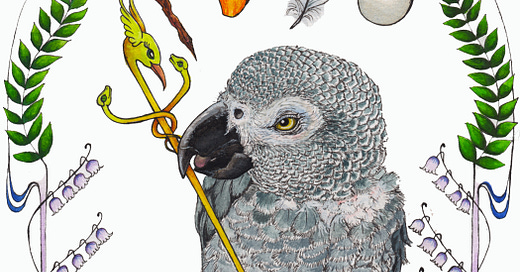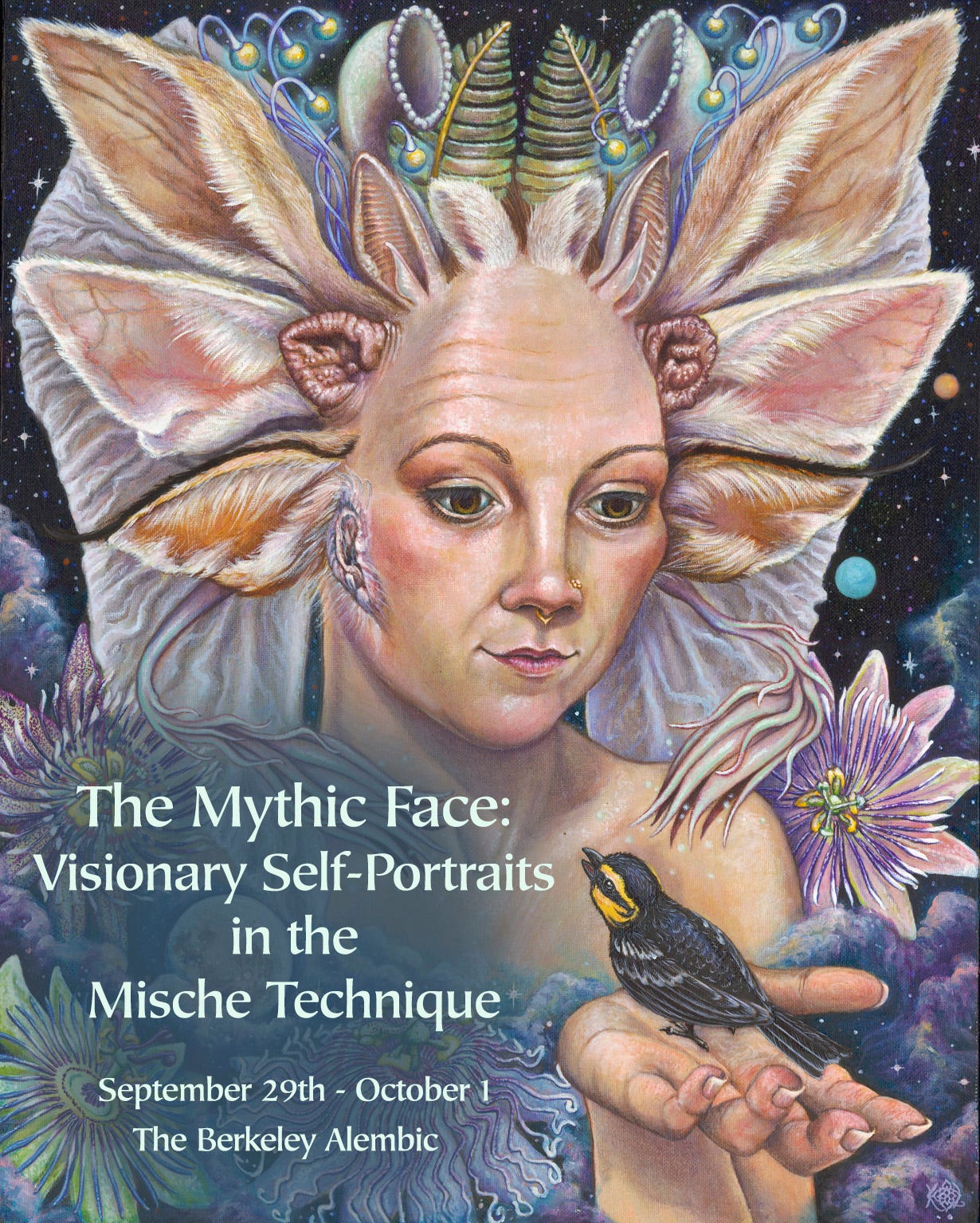1. The Magus
African Grey Parrot,
Magus of Power
Planetary Trump of Mercury
Hebrew Letter: Beth (House)
Color Scales: Yellow, Purple, Grey, Indigo, Flecked Violet
Correspondences: Lily of the Valley, Bay Laurel, Quartz, Alchemical Mercury
The Magician. The Hermetic title for them is the Magus of Power. According to the Western tradition of the Golden Dawn, the Magician is represented by the planet and the god, Mercury, or Hermes in Greek. They are the messenger of the gods and the divine trickster, moving freely between the worlds of mortals, the divine and the dead. They’re swift in actions, thoughts and words. The Magus a psychopomp, a guide through the underworld, and is the only being that can go into the realms of the dead and return to the of the light of day. The Magus is also associated with the God Thoth, the Egyptian inventor of writing, a master of speech and language and the scribe of the gods. What parrot in the world embodies these traits better than an African Grey?
The Magician is a channel for creative impulse. They’re a great communicator and apply intelligence in building their life. The Magus is duality. They represent both truth and falsehood, wisdom and folly. When you get this card, think of all the ways in your life that you are applying your intellect, applying your speech and words and creativity to get things done. Reflect as well on all of the inner worlds you traverse and think of The Magician as your guide so that you can plumb the depths and return unscathed.
The African Grey parrot on the card holds the caduceus wand, a symbol of Hermes. The snakes wound around it are a symbol of fertility and the beginning of new things. Our Magus in the card is about to chew on the wand because, well, that's what parrots do.
The Magus sits atop clear quartz crystals, also called rock crystal. The quartz reflects everything around it, bouncing the light back out to anyone looking through it. Quartz is associated with divination and healing. It's been found in prehistoric toolkits at archeological sites, and is linked with shamanic traditions worldwide into the present day. It's useful in dream work, spells and enchantments, and also as protection against hexes. Basically, you can count on a quartz crystal to amplify your magical and spiritual workings. It’s a perfect complement to the energies of the Magus.
Below the crystal is the Orphic egg. The Orphic egg is Greek mythology’s version of the ancient idea of the cosmic egg, which is born out of the chaos at the dawn of time. When it hatches, a great being emerges from it that becomes the parent of all things. This is a One who formed itself from the Nothingness, or Zero. Since The Fool is Zero, The Magus is then the One, exactly like the egg. From this moment on, the rest of the tarot is going to unfold from this moment of creation.
Above the Magus we see the four suits arise: Sticks for Wands, Eggs for Cups, Feathers for Swords and Fruits for Disks. The fruit on this card is a palm fruit, something that African greys love to eat in the wild. On the sides of the card are Lilies of the Valley and Bay Laurel plants. Lilies of the Valley traditionally represent humility and Bay Laurels were used as wreaths in Greek and Roman times, worn around people’s heads as symbols of status and of victory. These two things coming together are essential. It's good to be bold, but it's also good to be humble, and these aspects must stay in balance for any Magician to truly inhabit their power.
Peeking out from behind our Magician and the quartz crystals is something called a cynocephalus, which basically means “dog-headed being.” Aleister Crowley and Lady Frida Harris in their Thoth Tarot represented the idea of a cynocephalus as a monkeyman-type entity, so as a nod to their tradition, I will use a similar depiction here. But what does this creature represent?
As a Magus of Power, we can attain spiritual enlightenment and experience the divine source of all things. Whether or not you are a magician, you’ve probably had an experience that was so sublime, so beautiful, that you felt like you’d somehow come in contact with that moment’s essential nature. Now try and explain that moment to someone else, try and put that experience into words. It’s impossible. Our language cannot encompass the ineffable, cannot truly describe the numinous, and cannot come close to encapsulating the essential experience of being. It can be very frustrating to try and talk about these things because at some point, words just fail. This is the cynocephauls’ role. He is the monkey on your back that doesn’t let us speak the truth because there are no words to adequately articulate it.
There’s something so basic about this concept that expresses our human condition. The more I thought about it, the more I felt that it speaks to the condition of so many other beings, as we strive to communicate to each other over potentially vast chasms of difference. As a symbol of this card, there could be nothing more perfect than to show us that as a parrot in captivity, there's nothing that an African grey can say to us as their owners that will truly express what he wants or needs or feels. I ponder this a lot with my own African Grey, Sam, who this card is a portrait of. We’re so different, and yet we're so similar in so many essential ways that we can understand each other in great depth. Yet at the same time, there's a communication breakdown that is insurmountable and, at some level, heartbreaking.
Sam is sixteen years old and we've had him for five years at the time of writing this. He's my little trauma baby, and a rescue. I portrayed him here as he often is, with missing feathers. When we got him, he was almost totally naked and didn't have a tail at all. His first family was terribly abusive, and when he was rescued from them he was in bad shape. His second family was lovely but it wasn’t his forever home. Then we found him on Craigslist and now he’s ours forever. He’s done a lot of healing, opening and learning to trust and still has more to go, but then, don’t we all? I adore him more than anything else in the world. The Magus is his card, and he’s a perfect representative of his species with all he’s been through in his life, and the hope and resilience he has moving forward into a better one.
African greys are from the Phasianidae family and are native to equatorial Africa, thriving from Kenya all the way to Ivory Coast. They mostly live in dense forest but can be found in open vegetation areas, and they live in large flocks and family groups. Greys mate for life. They're monogamous and each pair makes their home in their own tree hollow. You can quickly surmise how deforestation can become a problem. While deforestation is a major threat, the number one thing endangering wild African Greys is the illegal pet trade. Between 1994 and 2003, 359,000 individual birds were traded in the international pet trade market. That number is a deep underestimation, since most of the birds traded are funneled through the black market and not officially counted. Many of these wild-caught birds die during transportation. Many more die before they get to wherever they end up, or perish shortly after arrival because they’re taken in by someone who doesn’t know how to care for them. It’s a tragic fate.
There is some good news, though. In 2016 the Convention on International Trade of Endangered Fauna and Flora extended its highest protection to African gray parrots by listing them in Appendix One, which bans global and domestic trade. Organizations like The World Parrot Trust and several others are doing amazing things to reach out to local people and communities that care about these birds and have them help stop poaching. African Greys represent spirits and deities in local religions and cultures, and they are highly revered. Incidentally, in Yoruban mythology, the Grey is a form the trickster god takes on, and their red tail feathers are made into sacred protection talismans.
In the wild, they eat fruit, nuts, seeds, tree bark, insects, snails…basically, they eat all sorts of stuff. In captivity we have to be really careful that they get a diet that gives them what they need nutritionally, and that we don't give them people food no matter how much they want it. Just like kids, Greys only want what's bad for them and tastes the best. They are highly curious but cautious, energetic and stoic, playful and quiet. They are incredibly complex social beings with intensely individual personalities, just like us.
I can’t speak about Greys with mentioning the work of Dr. Irene Pepperberg and her famous Grey, Alex. Her research revolutionized the dogmatic science of animal behavior and cognition. She came into a world where scientists still believed in the archaic notion that animals were automatons and only reacted to their environment through stimulus and response. Dr. Pepperberg, in her amazing book, Alex and Me, tells the story of how she bought a pet store parrot, revolutionized the science of animal intelligence, and fell in love with a truly amazing little guy that believed in her more than anyone else. By some luck, she chose one of the smartest parrots in the world. A recent study at Harvard showed how African Greys can be compared to the intelligence of a five-year old human child. Truly a bird of Hermes and Thoth if there ever was one.
Here is this week’s instructional YouTube video, part 2 of where I finish glazing in the face of the Cherub.
HERE are details for my upcoming in-person painting workshop.





